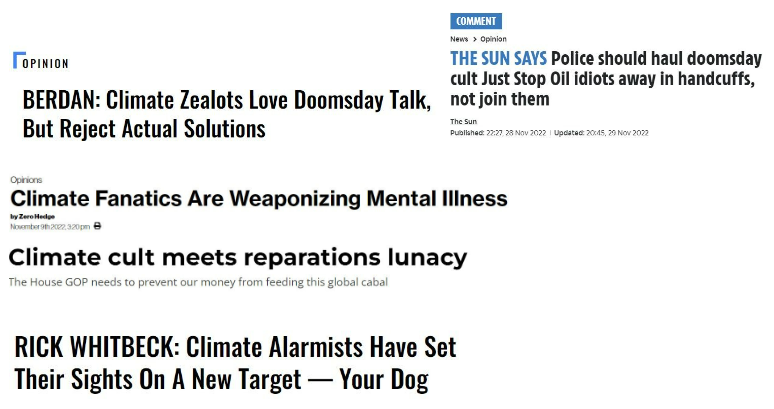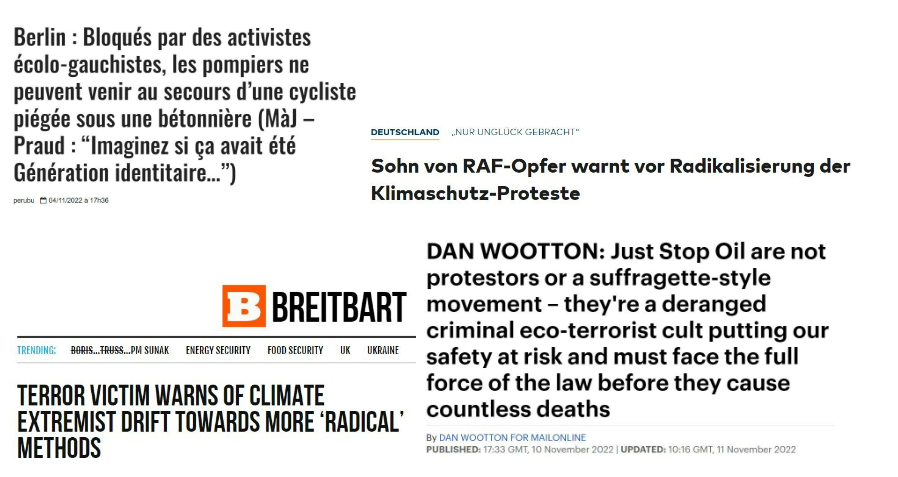How mainstream and ‘alternative’ media news headlines frame climate activism
15 February 2023
This Digital Dispatch builds on the analysis of more than 8,000 climate-related news stories published in English-, German- and French-language media outlets. It explores headlines used in both mainstream and so-called alternative media outlets, comparing how editorial teams engage with or promote ‘anti-climate activism’ narratives.
_________________________________________________________________________________
In 2022, German linguists and journalists voted the expression ‘Klimaterroristen’ (climate terrorists) as Germany’s ‘Unwort’ (non-word) of the year. The jury explained that the expression has been used to discredit climate action and the implementation of goals agreed in the Paris Agreement. It also noted that the expression aims to defame or criminalise legal protesting and civil disobedience, unfairly framing climate activism as violent extremism or terrorism.
This is not solely a German phenomenon but can be found in English- and French-language media outlets. This Dispatch unpacks the prominence of misleading and sometimes toxic word choices in climate coverage, analysing rhetoric that ridicules, stigmatises or discredits climate activism in both mainstream and alternative media outlets – the latter was categorised based on their self-ascribed oppositional role in media reporting (more on this, see Methodology below).
To conduct this analysis, ISD collected media stories whose headlines contained keywords related to climate or climate activism. This was done using Method52, a data collection and analysis capability built by CASM Technology and Media Cloud, an open-source platform that fetches news story URLs from RSS feeds associated with media sources. ISD then developed bespoke keyword-based dictionaries to classify collected media stories by ‘anti-climate activism’ narratives:
- ‘Climate hysterics’: captures narratives that insult, discredit or ridicule climate protests, for example, dismissing them as ‘hysterical’, ‘fearmongering’ or ‘idiotic’;
- ‘Climate terrorists’: captures narratives that associate and compare activism with Red Army Faction (RAF) terrorism, left-wing extremism, or organised crime, framing climate activism as a security threat;
- ‘Climate elites’: captures narratives accusing climate activists of ‘woke-ness’, ‘global elitism’ or ‘cancel-culture’, including claims of ‘climate lockdowns’ or ‘climate scams’.
The narratives are not mutually exclusive, meaning that some media stories were categorised as overlapping more than one narrative, for example, if a headline referred to ‘climate crazies’ and ‘climate criminals’. In total, ISD collected 8,698 media stories (1107 alt-media, 7591 mainstream media) from a seed list of 205 media sources in English, German and French that were published between 1 November and 15 December 2022.
Findings
ISD found that 35 percent of news headlines published in alternative outlets (393 out of a total 1107) and eight percent in mainstream outlets (634 out of a total 7591) contained keywords of at least one ‘anti-climate activism’ narrative.
For alternative outlets, the remaining 65 percent of headlines still largely discredited the need for climate action, including misinformation about alleged ‘climate reparations’ and ‘undue benefits’ of such to China; or specific attacks against US Congresswoman Alexandria Ocasio-Cortez for her climate change documentary. Some headlines that were not captured by keywords also featured subtle forms of ridiculing or discrediting activists, including attempts to delegitimise activists who receive funding from the Climate Emergency Fund, an environmentalist grant-making organisation that was co-founded by US philanthropist Aileen Getty, granddaughter of oil tycoon J. Paul Getty.
Headlines in both mainstream and alternative outlets were classified into narratives, noting that some headlines were double-counted as narratives are not mutually exclusive:
- ‘Climate hysterics’: with a total of 499 headlines, the most prominent narrative in the dataset;
- ‘Climate terrorists’: second most prominent with a total of 418 headlines in the dataset;
- ‘Climate elites’: least prominent with a total of 175 headlines in the dataset.
‘Climate hysterics’: Mocking climate activists
‘Climate hysterics’ was the most prominent narrative in the dataset of all languages. Demeaning terms were used to describe activists, for example in the context of protests in museums where artworks were defaced. English-language headlines described activists as “idiots”, “crazies”, “freaks” or “nuts” as well as using language claiming they were exaggerating about the impacts of climate change (e.g., “fearmongers” or “scaremongers”).
Alternative outlet InfoWars alleged that a “Climate cult [is] leading us into WWIII,” drawing on wider claims about climate change being a “woke religion.” This is also visible in headlines referring to activists as “eco-zealots”, “climate alarmists” or “climate fanatics.” Right-leaning outlet The Washington Times titled one piece “Climate cult meets reparations lunacy,” while right-leaning tabloid The Sun called protestors a “doomsday cult.”

Screenshots 1: Sample headlines of the ‘climate hysterics’ narrative.
Climate activists turning their attention to museums and art galleries toward the end of 2022 played a prominent role in the evolution of the ‘climate hysterics’ narrative. When ‘Ultima Generazione’ (Last Generation) threw flour on Andy Warhol’s work in Milan, headlines for example framed the stunt as “more idiots” being “allowed to damage priceless art.”


Screenshots 2: Sample headlines of the ‘climate hysterics’ narrative.
These headlines suggest that activists wilfully destroy artwork. However, museums and conservators have been sympathetic to the activists, further describing the choice of museums as a backdrop for protests as a testament to their symbolic power and relevance in discussions around the climate emergency.
In German media, the term ‘Klima-Kleber’ (climate gluers) was among the most prominent, with more than 200 mentions in both alternative and mainstream outlets. While the expression describes the phenomenon of activists gluing themselves to streets or objects, it comes with a contemptuous and mocking perception. Alternative outlets furthered such rhetoric, referring to activists as “Klima-Kleber-Trottel” (climate gluer fools), “Klima-Kröten” (climate toads), or “Klima-Sektierer” (climate cultists).
![Screenshots 3: Sample headlines of the ‘climate hysterics’ narrative (Translations: ‘Strange optics of [Intelligence Service] chief: climate sectarians commit crimes - not so bad’; ‘Outrage! Now they laugh at the climate gluer fools from the Elbphilharmonie’).](https://www.isdglobal.org/wp-content/uploads/2023/02/climheadlines3.png)
![Screenshots 3: Sample headlines of the ‘climate hysterics’ narrative (Translations: ‘Strange optics of [Intelligence Service] chief: climate sectarians commit crimes - not so bad’; ‘Outrage! Now they laugh at the climate gluer fools from the Elbphilharmonie’).](https://www.isdglobal.org/wp-content/uploads/2023/02/climheadlines3.png)
Screenshots 3: Sample headlines of the ‘climate hysterics’ narrative (Translations: “Strange optics of [Intelligence Service] chief: climate cultists commit crimes – not so bad”; “Outrage! Now they laugh at the climate gluer fools from the Elbphilharmonie”).


Screenshots 4: Sample headlines of the ‘climate hysterics’ narrative (Translations: “Global warming: Steven Koonin against the fearmongers”; ““An explosion of morons”: Andréa Kotarac denounces the actions of environmental activists”).
Adopting ‘catchy’ expressions such as ‘Klima-Kleber’ is a known practice in newsrooms, enticing readers with emotive language and increasing click rates. But it also, obviously, skews perceptions. In most cases in the ‘climate hysterics’ dataset, headlines were intended to bias readers against the events described, regardless of their legitimacy or nuance.
‘Climate terrorists’: Framing climate activists as a security threat
ISD found that the ‘climate terrorists’ narrative was the second-most prominent in German-language alternative outlets, following the ‘climate hysterics’ narrative. Figure 2 visualises the share of headlines related to observed narratives across both, outlets and languages.
Out of a total 418 media headlines related to the ‘climate terrorists’ narrative across all languages, the majority (about 80 percent) were published by German-language outlets, as comparisons with the former left-wing extremist group Rote Armee Fraktion (RAF), which conducted deadly terrorist attacks throughout the 1970s and 80s, emerged in the German public debate. For example, alternative outlet COMPACT suggested that an ex-terrorist “praised climate extremists”, citing an article by a former member of the RAF published in left-leaning outlet TAZ. The original article, however, argued that there is no “climate RAF” and that public outrage is not justified. Mainstream outlets, referencing an interview in tabloid BILD, reported that a terrorism expert warned of ‘radicalised’ climate activists.


Screenshots 5: Sample headlines of the ‘climate terrorists’ narrative (Translations: “Ex-terrorist praises climate extremists”; “Climate gluers are on the way to RAF”) .
In this context, headlines in both alternative and mainstream media also widely used the accidental death of a cyclist in Berlin to frame protesters as ruthless extremists. The accident happened in proximity to a road blockade organised by Last Generation, though the protest did not cause the accident. A traffic jam caused by the blockade delayed the arrival of an emergency response vehicle at the scene, leading to many headlines conflating the two events and suggesting that activists willingly permitted the death of an innocent person. Alternative outlets used emotive language, for example referring to activists as “Klima-Sadisten” (climate sadists).


Screenshots 6: Sample headlines of the ‘climate terrorists’ narrative (Translations: “Climate terror claims its first victim”; “Climate extremists as a prelude to a Green Army Faction?”; “Climate sadists: Truck had to run over victim twice”).
This German take seeped into French- and English-language media. One French headline asked whether climate activists had blood on their hands (“ont-ils du sang sur les mains?”). Alternative outlet Fdesouche.com (French) implicitly compared climate activists with the far-right Identitarian Movement (“Imaginez si ça avait été Génération identitaire”).
Reiterating an alleged security threat, alternative outlet Breitbart (English) also cited an interview with the son of a murdered RAF victim warning of the radicalisation of activists, originally published in German mainstream outlets. Meanwhile, mainstream outlet Daily Mail called activists a “criminal eco-terrorist cult” that would cause “countless deaths.”


Screenshots 7: Sample headlines of the ‘climate terrorists’ narrative (Translations: “Son of RAF victim warns of radicalisation of climate protests”; “Berlin: Blocked by eco-left-wing activists, firefighters cannot come to the rescue of a cyclist trapped under a concrete mixer truck (Update – Praud: Imagine if it had been Génération identitaire”).
ISD found that mainstream outlets providing a platform to terrorism experts and former extremists in their coverage on climate protests – even when the intention was to debunk such connections – can be easily misused by alternative media to reinforce the ‘climate terrorists’ narrative.
Calls for tougher penalties for climate activists
Reinforcing the ‘climate terrorists’ narrative, media outlets began to angle stories around tougher punishments for climate activists. Mainstream headlines widely reported on calls for “preventive detention” and listing climate groups as “criminal organisations.” In the context of police raids against ‘Letzte Generation’ in Germany, alternative outlets went further by comparing activists to adherents of ‘Reichsbürger’, an extremist movement that planned a coup against the German government. It seems headlines were amplifying a public debate shifting focus away from the central climate activism causes, to how to punish and criminalise activists.


Screenshots 8: Sample headlines of the ‘climate terrorists’ narrative (Translations: “25 investigative teams against serious crime – Islamists, Climate-Gluers, Car thiefs – Berlin: Where normal police work is not sufficient”; “Raid – Following the Reichsbürger, the “Last Generation” has now also been caught”)
When it came to mainstream reporting only, right and centre-right leaning outlets had the highest share of headlines related to any of the ‘anti-climate activism’ narratives as visualised in Figure 3. In many instances, headlines quoted politicians, public prosecutors, police or intelligence services. For example, German-language headlines widely quoted Friedrich Merz, leader of the conservative CDU party, who called activists “criminal offenders,” fuelling calls for a blanket criminalisation of climate activism. Figure 3 visualises the share of narratives in mainstream media across the political spectrum.
‘Climate elites’: Spreading anti-’woke’ and ‘climate lockdown’ messaging
A considerable number of headlines (175 in total) across all languages linked climate activism with the notion of ‘hypocritical global elites’ who would force their alleged ‘woke-ness’ on citizens. Narratives in this grouping also included references to ‘climate scam’, a trope discussed at length in ISD’s recent ‘Deny, Deceive, Delay’ report. ISD found that ‘climate elites’ was mainly pushed by English-language alternative outlets, with about 70 percent of the total stories in this narrative coming from these sources. The headlines included conspiratorial claims about climate policies and pushed the terms “climate lockdowns” and “Covid PsyOps,” discrediting climate activists as “communists” who would seek the “annihilation of the West.”


Screenshots 9: Sample headlines of the ‘climate elites’ narrative.
German-language media, both mainstream and alternative, also reiterated claims about ‘climate elites.’ Alternative outlets further alleged “climate censorship” and “surveillance”, including conspiratorial claims about a “transhumanist master plan.”


Screenshots 10: Sample headlines of the ‘climate elites’ narratives (Translations: “The questionable struggle of the climate protection elite for social sovereignty”, “Why “elites” like Greta Thunberg hate capitalism”, “Climate and gender policy as part of a transhumanist master plan?”).
French-language outlets adopted a more political framing, calling climate activists “militants écolo-pastèques” (watermelon environmentalists = green on the outside, red on the inside) or “écolo-gauchistes” (eco-leftists). Alternative outlet Résistance Républicaine referenced former Obama advisor, now climate sceptic, Steven Koonin to call out the “lies” of the “alleged climate emergency.”


Screenshots 11: Sample headlines of the ‘climate elites’ narrative (Translations: “Eco-leftists of Dernière Rénovation mauled by immigrant children: do we have the right to laugh?”, “Even Obama’s former climate advisor denounces the lies of the so-called climate emergency”; “The écolo-pastèques are characterised not by love of creation, but by nihilism”).
The rhetoric suggests that climate activists appropriated environmental concerns to advance socialist or communist ideas, which in turn reiterate negative connotations. It also presents climate action as an extreme or fringe concern tied exclusively to a far-left political ideology.
Conclusion
The use of undifferentiated or defamatory rhetoric, as shown in the three narratives analysed above, has been a key part of the climate delayist strategy that targets the legitimacy of any activism or advocacy. Such tactics do not need to address the science or even specific solutions or technologies. Instead, they portray those demanding urgent and decisive action as mentally unstable, quasi-religious fanatics, security threats or part of nefarious conspiracies.
This analysis shows how climate coverage can frame a public debate. Around 35 percent of headlines by so-called alternative media promoted one or more of the ‘anti-climate activism’ narratives. Whilst a smaller share of mainstream headlines contained such language. Nonetheless, both used offensive and dismissive terms to discredit or ridicule activists. In some instances, mainstream and alternative media seemed to echo or amplify each other.
Many headlines reflect the well-known phenomenon of ‘bothsidesism’ or ‘false balance fallacy’ – a nod to so-called ‘balanced objectivity’ in reporting, despite scientific consensus overwhelmingly tipping the conversation in one direction. Emotive, incendiary coverage on climate activism skews the focus to methods of resistance rather than the central arguments behind climate action. When amplified across the media ecosystem, this only serves to interfere public debate on key policy issues like the pace and scale of Net Zero transitions.
Appendix: Methodology
This Dispatch focuses exclusively on the title of news stories related to climate and climate activism, rather than the content of articles as a whole. This reflects studies that highlight the importance of headlines in online communication. For example, one study estimated a majority (59%) of the URLs mentioned on Twitter are never actually clicked on, indicating that many users retweet articles without ever reading them. Worse, another study found that audiences who only read article previews think they know more than they do in practice.
A seed list of media sources, gathered via Media Cloud, was coded into mainstream or alternative outlets. The latter was determined based on their self-description, for example framing themselves in direct opposition to ‘mainstream’ opinion and reporting. These outlets also have a track record of publishing stories that centre around broader ‘culture war’ issues, including far-right, conspiracy and climate denialist content. Some of this overlap has been evidenced in previous ISD research that maps ‘climate lockdown’ narratives. In addition, mainstream outlets were categorised as leaning either left, centre-left, centre, centre-right, or right on the political spectrum. This allowed for better comparison across languages (given that terms such as ‘liberal’ or ‘conservative’ confer different meanings depending on the context) and were based on existing models, including eurotopics, Media Bias/Fact Check (MBFC), NewsGuard, YouGov, and AllSides Media Bias Ratings™.
Due to limitations in how Media Cloud collects data, not all relevant outlets, especially alternative ones, could be considered in the collection. The table below summarises the dataset and coding of political biases.
| Language | Type | Number of media sources | Coded Political Bias |
| English-language (UK and US based) | Mainstream | 67 | Right: 8 |
| Centre-right: 8 | |||
| Centre: 15 | |||
| Centre-left: 31 | |||
| Left: 4 | |||
| Public: 1 | |||
| English-language (UK and US based) | Alternative | 38 | |
| German-language (Germany based) | Mainstream | 41 | Right: 3 |
| Centre-right: 9 | |||
| Centre: 15 | |||
| Centre-left: 4 | |||
| Left: 2 | |||
| Public: 8 | |||
| German-language (Germany based) | Alternative | 14 | |
| French-language (France based) | Mainstream | 33 | Right: 1 |
| Centre-right: 11 | |||
| Centre: 12 | |||
| Centre-left: 4 | |||
| Left: 2 | |||
| Public: 3 | |||
| French-language (France based) | Alternative | 10 |
ISD then created a thematic keyword list to capture news headline related to climate change and climate activism. This included terms in all three languages related to climate activism (e.g., activistes écolos, eco protests, Öko-Aktivisten), activist groups (e.g., Extinction Rebellion, Just Stop Oil) and broader terms like ‘climate’ to cover the range of relevant stories. Given that a broad keyword selection can lead to collecting irrelevant data, ISD coded a random sample of 200 media stories to verify the thematic relevance of the dataset (accuracy rate = 98 percent). Based on qualitative scoping of news stories and previous ISD analysis of climate mis- and disinformation, ISD developed keyword-based dictionaries related to ‘anti-climate activism’ narratives. Dictionaries were then tested and used to classify the collected news headlines.



